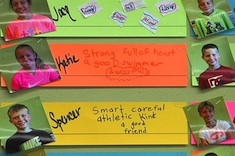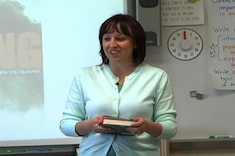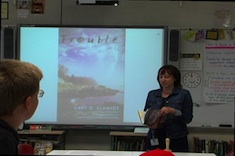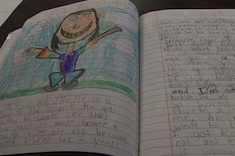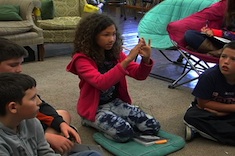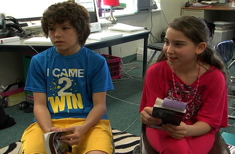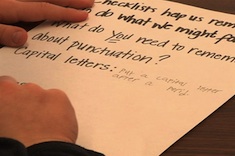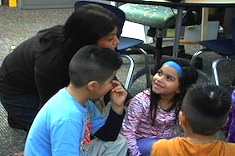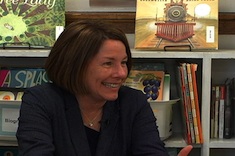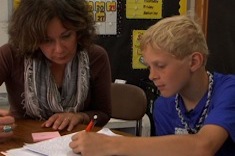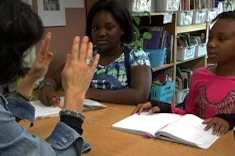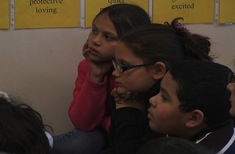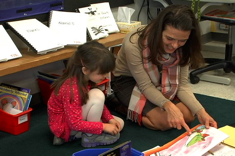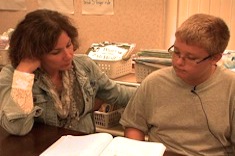Videos
Here is where you’ll find all the latest videos from our contributors. These videos are all captured in classrooms with crews using multiple cameras during regularly scheduled reading and writing workshops.
Latest Content
Plans for Writing Circle
Stella Villalba starts writing workshop with her young English language learners by having everyone share their plans in a community circle.
Adding “Girly” Books to a Next-Read Stack
Katherine Sokolowski helps a fifth grader add more "girly" books to her next-read stack.
Mentor Texts for Crafting Nonfiction
Melanie Meehan talks with a third-grade teacher about how she helps students focus on craft elements in nonfiction mentor texts.
Reflective Transitions
Christy Rush-Levine helps her eighth-grade students launch the work period with a reflective question that sets a tone for productivity, and then returns to it throughout the morning during transition times.
Student Interest Board
Katherine Sokolowski shares a wall display from her fifth graders that students build to celebrate who they are and people they love from home.
Conferring with Ashley: Pink Hair
Ruth Ayres confers with a first-grade writer early in the year. This brief conference with a simple text is all about building a rapport in September and celebrating illustrations.
The Living: Book Talk
Christy Rush-Levine introduces The Living to her eighth graders.
Book Talk: Trouble
Christy Rush-Levine previews the book Trouble by Gary D. Schmidt.
Conferring with Ben: Brainstorming Writing Topics and Genres
Katherine Sokolowski helps fifth grader Ben brainstorm ideas for writing, and in the process encourages him to try a new genre.
Nonfiction Research Group in Fifth Grade
Katherine Sokolowski meets with a group of fifth graders who are all researching the use of nets in fishing and the environmental effects of the process. She works to build connections among classmates as well as research skills.
Book Talk: When We Broke Up
Christy Rush-Levine piques the interest of her eighth graders in When We Broke Up by Daniel Handler.
Tweeting a Favorite Author
Katherine Sokolowski helps one of her fifth-grade students compose a tweet to a favorite author.
A Formula for Great Book Talks
Christy Rush-Levine explains her formula for successful book talks in middle school that grab students' attention. We've also included a sample book talk.
Building Annotation Skills with Partners
Gretchen Taylor works from homework surveys to help her middle school students collaborate with partners to build annotation skills.
Developing Individualized Convention Checklists with Students
Melanie Meehan works with third graders to develop personalized conventions checklists.
Modeling Nonfiction Writing for English Language Learners: Part 3
Stella Villaba models nonfiction writing for her first- and second-grade English language learners, and in the process integrates vocabulary instruction into her lesson. This is the final video in a three-part series.
Modeling Nonfiction Writing for English Language Learners: Part 2
Stella Villalba models nonfiction writing for her first- and second-grade English language learners, and in the process integrates vocabulary instruction into her lesson. This is the second video in a three-part series.
Modeling Nonfiction Writing for English Language Learners
Stella Villalba models nonfiction writing for her first- and second-grade English language learners, and in the process integrates vocabulary instruction into her lesson. This is the first video in a three-part series.
From Compliments to Challenges: The Conferring Card
Melanie Meehan uses a conferring card in her writing conference with Cara to ensure she has a record of the strengths and revision possibilities they discussed.
Pausing for Reflection in Second Grade
Sean Moore helps his second graders remember the classroom routines and protocols for sharing reading reflections through a circle group.
Maintaining Momentum As a Writer
Jennifer Richard Jacobson chats with a group of fifth graders about how to generate ideas for writing independently each day.
Kindergarten Reading Conference: Building Confidence
Mandy Robek finds that kindergartner Mikey is lost in knowing how to use his time well during reading workshop. Her conference moves him from deflated to inspired.
Conferring Over “Finished” Writing
Ruth Ayres challenges Grant to add paragraphs to his “finished” piece.
Owl Research Brainstorming: Partner Work
Andrea Smith’s fourth graders are working on an Owl Research project that integrates reading, writing, talking, listening, and content literacy.
Understanding Character Traits: Part 3
Jason DiCarlo completes his lesson on character traits in third grade. This is the final installment in a three-part series.
Understanding Character Traits: Part 2
Jason DiCarlo continues his third-grade reading workshop lesson on character traits with a mentor text. This is the second video in a three-part series.
Understanding Character Traits Lesson
Jason DiCarlo leads a lesson in third grade on character traits. This is the first video in a three-part series.
Making Home Connections While Conferring
Ruth Ayres meets with Zoey, a quiet writer who is drawn into the conversation through family stories and a mentor text with vivid illustrations.
Conferring with Jeri in Kindergarten
Mandy Robek demonstrates the strategies of teach, prompt, and reinforce when conferring with kindergartner Jeri.
A Thesis Statement: Conferring with Connor
Ruth Ayres confers with sixth grader Connor about constructing a thesis statement.
Browse Content By
Type
Category
- Assessment Tools
- Big Fresh Archives
- Booklists
- Choice Numeracy
- Classroom Design
- Common Core
- Community Building
- Conferring
- Content Literacy
- Digital Literacy
- English Language Learners
- Equity
- Family Relations
- Free Samples
- Guiding Groups
- Leadership
- Literacy Coaches
- Mentor Texts
- Minilessons
- New Teacher Mentors
- Podcasts
- Poetry
- Quote Collections
- Reading Strategies
- Self Care
- Struggling and Striving Learners
- Talking and Listening
- Teacher Study Groups
- Teaching Reading
- Teaching Writing
- Word Study and Vocabulary
Author
- Melissa Quimby
- Nawal Qarooni
- Gwen Blumberg
- Julie Cox
- The Lead Learners
- Hannah Tills
- Josie Stewart
- Ruth Metcalfe
- Mallory Messenger
- Becca Burk
- Jodie Bailey
- Vivian Chen
- Mary Brower
- Tiffany Abbott Fuller
- Stephanie Affinito
- Ruth Ayres
- Leigh Anne Eck
- Heather Fisher
- Shari Frost
- Julie Johnson
- Suzy Kaback
- Gigi McAllister
- Shirl McPhillips
- Melanie Meehan
- Cathy Mere
- Debbie Miller
- Tara Barnett and Kate Mills
- Tammy Mulligan
- Dana Murphy
- Bitsy Parks
- David Pittman
- Brenda Power
- Heather Rader
- Matt Renwick
- Mandy Robek
- Christy Rush-Levine
- Gretchen Schroeder
- Jen Schwanke
- Brian Sepe
- Katherine Sokolowski
- Stella Villalba
- Jennifer Vincent
Grade Level
Choice Literacy Membership
Articles
Get full access to all Choice Literacy article content
Videos
Get full access to all Choice Literacy video content
Courses
Access Choice Literacy course curriculum and training





